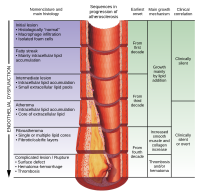
Photo from wikipedia
Epidemiological studies have demonstrated that cardiovascular diseases (CVDs) are the leading cause of death in the world. Atherosclerosis, a kind of chronic vascular disorder related to multiple pathogenic processes, has… Click to show full abstract
Epidemiological studies have demonstrated that cardiovascular diseases (CVDs) are the leading cause of death in the world. Atherosclerosis, a kind of chronic vascular disorder related to multiple pathogenic processes, has been reported to be an underlying cause of CVDs. Shexiang Baoxin Pill (SBP) is a traditional Chinese medicine formulation and has been broadly used for the treatment of CVDs in East Asia. However, whether SBP affects the development of atherosclerosis is poorly understood. The aim of this study was to investigate the antiatherosclerotic roles and relevant mechanisms of SBP in apolipoprotein E knockout mice. Our results showed that SBP treatment markedly decreased the size of atherosclerotic plaques of the entire aorta and the aortic sinus. Biochemical analyses indicated that SBP gavage improved oxidative stress in vivo, as seen by the level elevation of SOD, CAT, and GSH and the level reduction of MDA, H2O2, and MPO. Moreover, the concentration of MCP-1, IFN-γ, and IL-17A was reduced, and the content of IL-10 and TGF-β1 was increased in the serum from SBP-treated mice. We discovered that the expression levels of inflammatory factors including VCAM-1, ICAM-1, IL-6, and IL-2 in the vascular wall of the SBP group were also decreased in comparison with those of the normal saline group. Moreover, we found that SBP alleviated the activation of inflammation-related pathways in the aorta tissue, as seen by the level elevation of Mfn2 and reduced phosphorylation of p38, JNK, and NF-κB. Furthermore, western blot showed that SBP administration reduced the level of SR-A and LOX-1 and elevated the content of LXRα, ABCA1, and ABCG1 in the arterial wall, indicating that SBP was capable of alleviating lipid influx and facilitating lipid efflux. In conclusion, our data suggested that SBP exerted antiatherosclerotic effects via improving inflammation response and inhibiting lipid accumulation.
Journal Title: Mediators of Inflammation
Year Published: 2019
Link to full text (if available)
Share on Social Media: Sign Up to like & get
recommendations!